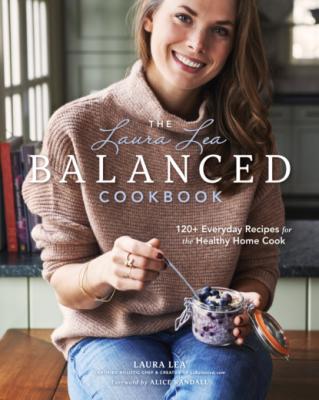The Laura Lea Balanced Cookbook. Laura Lea
Читать онлайн.| Название | The Laura Lea Balanced Cookbook |
|---|---|
| Автор произведения | Laura Lea |
| Жанр | Кулинария |
| Серия | Laura Lea Balanced |
| Издательство | Кулинария |
| Год выпуска | 0 |
| isbn | 9781951217112 |
• Toasted sesame oil*
VINEGARS
• White balsamic vinegar: This is my go-
to vinegar, and my husband actually
introduced me to it. Made from white grapes
and white wine vinegar, white balsamic has
a lovely flavor and a clean aftertaste. It also
has a hint of sweetness, and I think it is an
ideal base for salad dressings. If you want
a vinegar that is less intense than white
vinegar, I highly recommend this.
note: When a recipe calls for this in the
book, it is factoring in the natural sweetness
of white balsamic. If you substitute a more
acidic/less sweet vinegar, you should add
more sweetener to taste.
• Dark balsamic vinegar: A classic and staple
of our pantry. Good balsamic vinegar is
made from simmering grapes for hours
until they are syrupy and caramelized.
Dark balsamic has a rich flavor that is ideal
for adding complexity and acid to cooked
dishes. To concentrate the flavor even more,
you can purchase reduced balsamic vinegar
or reduce it yourself: simply add it to a sauce
pan and simmer until it reaches a syrupy
consistency. This is a dream drizzled on
fresh tomatoes in the summer.
• Apple cider vinegar (ACV): The most acidic
of these three, apple cider vinegar is made
from fermented apples. Used for centuries
in home and health-care applications, apple
cider vinegar has numerous purported
health benefits, such as improving digestion,
whitening teeth, and regulating blood sugar.
Raw, unfiltered ACV contains “the mother,”
a cobweb-looking substance made from
proteins, enzymes, and beneficial probiotic
organisms. While I do not find apple cider
vinegar to be the “cure all” that some have
touted, I do find that it can help settle a
stomach ache (I use 2 teaspoons in 1 cup
of filtered water). Primarily, I use ACV for
its astringent but neutral flavor when I
want a nice hit of acid in a sauce or even a
baked good recipe. I encourage you to do
some ACV research on your own if you are
interested in the health benefits.
HEALTY EATING ON A BUDGET
Follow the Dirty Dozen for organic selections.
I understand that organic food can get real
expensive real quick. As a result, I follow the
Environmental Working Group’s list called
the Dirty Dozen. This list includes fruits and
vegetables that are highest in pesticide
content. I try to buy organic versions of the
Dirty Dozen items, such as berries, leafy greens,
and apples. Visit EWG’s website (EWG.org) for the updated list.
Buy seasonal and local produce. Produce is
generally cheaper when it is in season, so look
for items from local or regional farms. Buy in bulk.
Chop fruits and vegetables into smaller pieces,
place in zip-top storage bags, and freeze. Use
as you would pre-packed frozen produce.
Check for sales and choose recipes accordingly.
Stay tuned-in to the sales going on at your
grocery stores. Make a list of the whole-foods
items on sale, then see which recipes in my book
(or another book, I guess) use those items. Again,
stock up and freeze anything that can be frozen
(see page 53 for help with that).
Ditch bottled drinks for homemade options.
My husband and I get bored with plain water,
and as much as we love seltzer and kombucha,
the cost of bottled drinks adds up quickly. As an
alternative, soak fruit in a pitcher of filtered water
overnight to infuse the flavor. I also do this with
cucumber and mint or basil. You can also try my
Cleansing Raspberry Ginger Water (page 86) or Workout Water (page 89).
Eat eggs. Eggs are inexpensive and incredibly
nutrient-dense. Always keep some in the fridge and
enjoy them as your protein in any meal or snack. Stir
a raw egg into some cooked grains over a little heat
for a quick “fried rice.” Make an easy egg salad
with a few hard-boiled eggs, a dollop of mayo, a
smaller dollop of Dijon mustard, and pinches of salt,
pepper, and onion powder. Delicious!
Visit the frozen section. There is nothing wrong
with frozen fruits and vegetables, so fill up your cart
and freezer and feel good about it. I almost always
use frozen organic kale and spinach in my green
smoothies. Not only is it cost-effective and longer-
lasting, but it makes for a creamier texture and
better flavor. Most produce is frozen right when
it’s harvested, so it can have even more nutrition
than some items that have traveled a long way
to get to you.
Get slow cooker–friendly. Cheaper cuts of meat
are generally tougher, but they can break down
beautifully in a slow cooker. Add a few pounds
of some of these tough cuts with enough water
to cover halfway, throw in some seasonings, and
let it cook for hours. Check out my Slow Cooker
Indian Butter Chicken (page 238) for an example.
Condi-meat. Say what?! Think of meat as a
